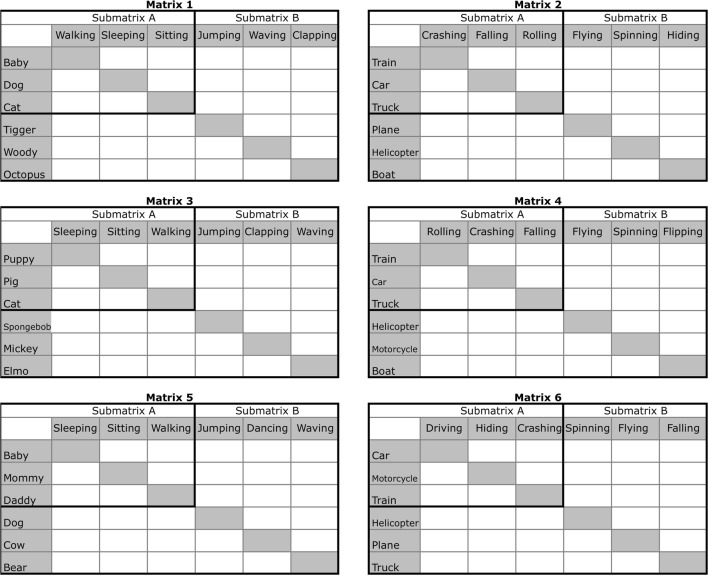Abstract
Children diagnosed with autism spectrum disorder (ASD) typically exhibit a range of social communication deficits. Presequenced stimulus arrangements, such as matrix training, can be used to facilitate generative responding. Accordingly, training procedures can lead to the acquisition of a greater number of targets that are not taught explicitly, with fewer learning trials. Matrix training provides a useful framework for selecting teaching targets to promote the emergence of untaught skills. Participants were 3 young boys diagnosed with ASD, who were taught noun-verb combinations of play actions as tact and listener responses. All participants learned the taught noun-verb targets and showed varying degrees of recombinative generalization to untaught targets. Across subsequent matrices, the rate of acquisition of new targets and the number acquired without direct teaching increased (i.e., recombinative generalization). This suggests matrix training stimulus arrangements can facilitate the acquisition of novel targets by teaching young children with ASD to recombine language components appropriately.
Keywords: Tacting, Listener responding, Verbal behavior, Matrix training, Recombinative generalization, Language, Autism
Communication deficits are common in children diagnosed with autism spectrum disorder (ASD) and can often take the form of limited spoken language, including limited vocabulary or short utterances (i.e., single words; APA, 2013). Behavioral interventions aimed at improving communication deficits often emphasize the use of discrete trial teaching in which a discriminative stimulus (e.g., presentation of toy plane) precedes the correct response (e.g., spoken word “plane”) and is promptly followed by the delivery of a reinforcer (e.g., social praise, preferred tangible or edible). Such an approach is widely used in early intensive behavioral intervention (EIBI) and has been shown to be effective in teaching children with ASD (Lovaas, 1987). This approach, however, has been criticized for producing “rote learning.” That is, individuals tend to emit the same communicative response (e.g., tacting “plane”) in the presence of the discriminative stimulus (e.g., toy plane), despite the presence of other relevant antecedent stimuli such as the therapist making flying actions with the plane and providing the instruction to say what the item is doing (i.e., the child is asked to tact noun-verb combinations).
Rote responding can be particularly problematic when teaching functional language to children with ASD, who are inclined to engage in repetitive patterns of behavior and may have difficulty generalizing learned skills to novel situations (APA, 2013; Stokes & Baer, 1977). The functional use of language requires individuals to employ learned words and sentence structures in novel and flexible ways. The use of generative instruction has been touted as an alternative teaching strategy, aimed at generating the maximum novel repertoire after teaching the minimum number of skills (Alessi, 1987; Goldstein, 1983).
Using generative instruction for communication skills, such as matrix training, instructors teach a subset of skills and new skills emerge without direct teaching (Rehfeldt & Barnes-Holmes, 2009; Sidman, 1994), resulting in the efficient acquisition of functional language in children with communication delays. Matrix training refers to a recombinative generalization framework for selecting teaching targets, in which components are arranged along horizontal and vertical axes such that their intersection creates novel combinations within the matrix. For instance, nouns and verbs can be arranged along the vertical and horizontal axes, respectively; the cells within the matrix result in noun-verb combinations. Within this framework, a subset of targets is explicitly taught. Recombinative generalization occurs when learners are able to emit untaught targets by combining elements of taught targets (Goldstein & Mousetis, 1989). For instance, if the learner were explicitly taught “dog walking” and “cat sitting,” recombinative generalization would be demonstrated with the learner independently emitting “dog sitting.”
Matrix training has been used to teach a range of skills to children with ASD, such as spelling (Kinney, Vedora, & Stromer, 2003), writing and receptive identification of letters and numbers (Axe & Sainato, 2010), play skills (Dauphin, Kinney, & Stromer, 2004; Jung & Sainato, 2013; Wilson, Wine, & Fitterer, 2017), and tacting emotions (Conallen & Reed, 2016). This approach also has been effective in teaching tacting and listener skills to children with intellectual disabilities (e.g., Goldstein, Angelo, & Mousetis, 1987); however, few studies have examined the usefulness of matrix training for expanding the communication repertoire of children with ASD (e.g., Axe & Sainato, 2010; Curiel, Sainato, & Goldstein, 2016; Frampton, Wymer, Hansen, & Shillingsburg, 2016).
Curiel et al. (2016) taught action-object listener responses using a matrix-training framework to a 31-month-old boy with ASD. After training, the participant was taught to emit response such as “give me dog” or “clean up cat,” and novel targets within the matrix were probed for generalization. Of the 16 untrained targets, this participant demonstrated recombinative generalization for 11 targets, suggesting matrix training can be beneficial to expand the listener repertoire of young children with ASD. This study, however, included one participant and thus far is the only study to our knowledge to employ matrix training with children with ASD under the age of five, which is the age during which EIBI services are typically delivered (see also Curiel, Sainato, & Goldstein, 2018, for related study).
Expanding vocabulary, lengthening sentence structure, and improving listener repertoires in children with ASD can be a time-consuming endeavor when conducted in the typical format of teaching each target in isolation. In addition to its inefficiency, teaching each target in isolation does not address the skill of using functional language flexibly by recombining words to form novel sentence structures. Thus, finding efficient methods to teach and expand language in this population has important implications for treatment design and time required to achieve treatment goals. The purpose of this study was to determine whether matrix training would be an effective method for selecting targets to expand the tacting and listener repertoires in young children diagnosed with ASD.
Method
Setting and Participants
The present study took place at a university-based autism treatment center. All sessions took place during each participant’s early intervention sessions, which were conducted 5 days per week in a classroom with several workstations. Therapists working with clients conducted matrix-training sessions within the regular instructional programming of each participant. For Hank and Bud, matrix-training sessions occurred on a floor mat, where naturalistic interventions were conducted. For Iggy, matrix-training sessions were conducted at a table. Materials present included a clipboard and data sheet for data collection, clickers, timers, toys, edible items, human and animal figurines, and toy vehicles.
Participants were three boys who were diagnosed with ASD using the toddler module of the Autism Diagnostic Observation Schedule, 2nd Edition (Esler et al., 2015; Lord, Rutter, DiLavore, & Risi, 1999), and who were 25 (Hank), 28 (Iggy), and 34 (Bud) months old and had received at least 4 months of EIBI at our center at the time of this study. All were considered early learners, with some Level 2 skills of the Verbal Behavior Milestones Assessment and Placement Program (VB-MAPP; Sundberg, 2008; see Table 1 for details), strong echoic repertoires, and previous experience with conditional discrimination training.
Table 1.
Verbal behavior milestones assessment and placement program (VB-MAPP) results and participant’s time receiving early intervention services
| Participant | Time in EI (in months) | VB-MAPP Results | ||
|---|---|---|---|---|
| Milestone score | Tact domain score | Listener domain score | ||
| Hank | 5 | 78.5 | 7 | 8 |
| Iggy | 4 | 57.5 | 6 | 7 |
| Bud | 7 | 74.5 | 6.5 | 8 |
Procedure
All teaching sessions were conducted within the participant’s EIBI sessions. During this time, participants interacted one-on-one with their therapist either at a desk or on a carpet. Participants received praise and access to a preferred item for correct responses. Preferred items were either a small edible (e.g., goldfish cracker) or 30-s access to a tangible item (e.g., iPad), identified via a multiple-stimulus without replacement (MSWO) preference assessment procedure (DeLeon & Iwata, 1996) conducted at the beginning of each daily session.
During teaching sessions, participants were exposed to a series of conditions in which they either performed an action with 3-D research materials (e.g., when the researcher said, “Show me ‘baby walking,’” the participant moved the baby doll along the tabletop) or labeled actions performed by the researcher (e.g., when the researcher asked, “What is it doing?” the participant said “baby walking”). Hereafter, these behaviors will be referred to as listener responding and tacting, respectively.
A six-by-six matrix, with nouns along the rows and verbs along the columns, was created to identify teaching and generalization targets. Within each matrix, nouns and verbs can be combined into 36 noun-verb targets. Nouns selected for inclusion in the study were mastered as tacts, determined via a review of clinical records or probes during which participants were asked, “Who [what] is it?” All verbs were novel targets, determined via probes during which researchers performed actions and asked, “What am I [is it] doing?” Figure 1 shows Matrices 1 and 2 used for Hank, 3 and 4 used for Iggy, and 5 and 6 used for Bud. Noun-verb combinations along the diagonal of the matrix served as initial teaching targets (shaded cells), whereas other targets were used to assess whether participants generalized learning to novel noun-verb combinations (white cells). For all participants, the two matrices were evaluated sequentially. Matrices were divided into two submatrices (A and B), which allowed for evaluation of generative instruction within and across target sets (figurines and vehicles).
Fig. 1.
Noun-verb matrices for Hank (1 and 2), Iggy (3 and 4), and Bud (5 and 6). Nouns are located along the first column and verbs along horizontal lines. All cells inside matrices form unique noun-verb combinations. Shaded diagonal cells and white cells comprise instructional and generalization targets, respectively
Baseline
All six targets along the diagonal of the matrix were probed as listener responding and tacting to establish baseline levels. Each of the noun-verb combinations along the diagonal was tested three to five times in randomized order. During this phase, there were no programmed consequences for correct or incorrect responses. Targets scoring above 60% correct during this phase were not included. In such cases, new targets were added to the teaching matrix.
For tacting responses, all stimuli were placed in front of the participant. The researcher would select an object (e.g., baby doll) and perform an action (e.g., walking) while asking “What is it doing?” If the participant vocally emitted the correct noun-verb combination within 5 s, this was scored as correct. Incorrect responses consisted of only the correct noun, only the correct verb, incorrect noun and verb, or no vocal response. For listener responses, all stimuli were placed in front of the participant and the researcher would say, “Show me [noun-verb]” (e.g., baby walking). Correct responses consisted of the participant correctly selecting the correct object (e.g., baby) from an array of three to six items and performing the correct action (e.g., walking) within 5 s of instruction delivery.
Training
The three targets along the diagonal of Submatrix A were trained initially (see Figure 1). No other targets were trained or probed during this condition. Trial blocks, referred to as sessions hereafter, consisted of five trials interspersing all training targets in varying order. Sessions were interspersed with other skill acquisition programs in the participant’s regular early intervention session. Training sessions were conducted similarly as in the baseline condition with the addition of prompts, error correction, and reinforcement. Throughout training, vocal prompts were used for tacting. The vocal prompt consisted of providing an echoic model of the correct tacting response, such as “baby walking.” For listener response targets, gestural (Hank, Iggy) or model (Bud) prompts were used. The gestural prompt consisted of pointing toward the correct item in the array, whereas the model prompt consisted of the researcher demonstrating the action with the correct object. For some targets (e.g., bear waving), Bud required physical prompts in which the researcher physically guided his hands to perform the action with the appropriate object. Prompts were faded using a progressive time delay, starting with 0 s and progressively increasing up to 5 s (MacDuff, Krantz, & McClannahan, 2001). Specifically, the experimenter conducted two sessions at a 0-s time delay. If the participant correctly responded to prompts during at least 80% of opportunities in those two sessions, the time delay was increased to 2 s. Subsequently, following correct responses to prompts or independent responses during at least 80% of opportunities in a single session, the time delay was increased to 3 s, and finally 5 s. Prompt-fading procedures were adjusted as needed for each participant as recommended by case managers. Targets were considered mastered after at least 80% independent correct responses from the participant per session for two consecutive sessions. Correct responses were immediately followed by praise and the delivery of a preferred edible or tangible item, as identified from the presession MSWO described earlier.
Generalization probes
Once participants reached mastery of the trained targets (i.e., diagonal, shaded cells in matrices displayed in Figure 1), the rest of the targets within the submatrix were probed for recombinative generalization (i.e., white cells in matrices displayed in Figure 1). That is, after learning nouns and verbs in one target configuration (e.g., baby walking, dog sleeping, cat sitting), nouns and verbs were probed in novel target configurations (e.g., baby sleeping, dog sitting, cat walking). For Submatrix A, six novel targets were probed during this condition. Subsequently, for Submatrix B, 24 novel targets were probed. If the correct noun-verb recombinative response was below 60% independent correct responding for novel targets, those targets were trained as described previously.
After the three initial diagonal targets were mastered and recombinative generalization probes were conducted for Submatrix A, the same process of training the three targets on the diagonal of Submatrix B and probing for recombinative generalization was conducted. Thus, training was conducted using a multiple-probe design across target sets or submatrices.
Interobserver Agreement
An independent observer either attended sessions and collected data simultaneously with the researcher or scored trials from a video recording of sessions. Trial-by-trial interobserver agreement (IOA) was calculated by dividing the number of trials of agreement by the total number of trials and multiplying this number by 100 to obtain a percentage score. For Iggy, IOA data for Matrix 3 are unavailable due to experimenter error, but for Matrix 4 these data were collected for 93% of trials, with trial-by-trial IOA resulting in 96.25%. For Bud, IOA data were collected for 14% of trials in Matrix 5 and 58% of trials in Matrix 6. Mean IOA for Matrix 5 was 100%, and mean IOA for Matrix 6 was 99.8%. IOA data are not available for Hank, but the protocol was implemented in the same manner as for Iggy and Bud and under the supervision of a Board Certified Behavior Analyst serving as the case manager for Hank in the university-based early behavioral intervention center.
Results
Table 2 shows the average sessions to mastery of initial training targets (i.e., diagonal of the matrix), average sessions to mastery of generalization targets that required training, and percentage of generalization targets that met mastery criteria without direct training for all participants. Overall, the number of sessions to mastery of diagonal targets decreased, and the percentage of targets that showed recombinative generalization without explicit teaching increased across subsequent submatrices.
Table 2.
Individual participants’ average sessions to mastery for diagonal targets, targets taught after failing to demonstrate recombinative generalization for each submatrix, and percentage novel noun-verb targets for which recombinative generalization was demonstrated without additional training
| Participant | Submatrix | Average sessions to mastery diagonal ● | Average sessions to mastery generalization Δ | Percent novel targets generalized | |
|---|---|---|---|---|---|
| Hank | Tacting | 1A | 11.7 | 4.5 | 66% |
| 1B | 0.0 | 6.0 | 83% | ||
| 2A | 9.0 | 5.0 | 83% | ||
| 2B | 7.0 | 8.0 | 83% | ||
| Listener | 1A | 8.3 | 4.0 | 83% | |
| 1B | 0.0 | 6.0 | 88% | ||
| 2A | - | - | - | ||
| 2B | - | - | - | ||
| Iggy | Tacting | 3A | 10.0 | 9.0 | 50% |
| 3B | 11.0 | 11.0 | 92% | ||
| 4A | 4.7 | 6.3 | 50% | ||
| 4B | 6.0 | 5.5 | 92% | ||
| Listener | 3A | 9.0 | 8.0 | 83% | |
| 3B | 0.0 | 8.7 | 88% | ||
| 4A | 4.0 | 6.5 | 66% | ||
| 4B | 6.0 | 5.7 | 83% | ||
| Bud | Tacting | 5A | 4.7 | 8.5 | 0% |
| 5B | 4.0 | 0.0 | 83% | ||
| 5A | 3.0 | 0.0 | 100% | ||
| 5B | 0.0 | 0.0 | 100% | ||
| Listener | 5A | 4.3 | 5.0 | 0% | |
| 5B | 0.0 | 0.0 | 88% | ||
| 5A | 3.0 | 0.0 | 100% | ||
| 5B | 0.0 | 0.0 | 100% | ||
Percentages of correct responding across sessions for tacting and listener responding for each participant are shown in Figures 2 through 7. In all figures, separate panels show data for each submatrix, which underwent training in sequential order. Data are depicted as aggregates for all diagonal (black data points) and generalization (white data points) targets in each submatrix. Figure 2 shows noun-verb tacting data for Hank. During baseline for Submatrix 1A, Hank had low levels (0%) of correct responding for tacting targets. The first three training targets were mastered within 7–12 sessions (see Table 2 for average sessions to mastery). After reaching the mastery criteria for the initial diagonal targets in Submatrix 1A, generalization probes were conducted, and any untaught targets with independent correct responses below 60% were taught. Table 2 shows the percentage of novel targets that met the criteria for recombinative generalization. The remaining two noun-verb combinations in Submatrix 1A required remedial training to reach mastery criteria. These targets reached mastery in fewer trials than the initial diagonal targets, as can be seen in Figure 2 and Table 2.
Fig. 2.
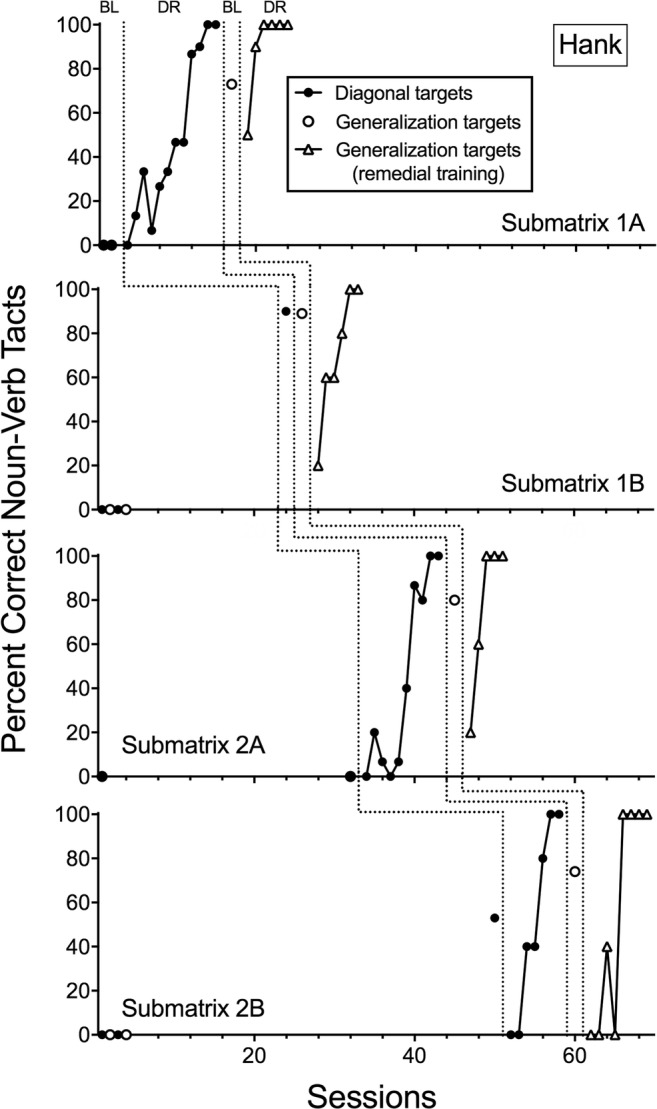
Percentage correct noun-verb tacts across experimental sessions for Hank. Each panel shows data for each submatrix across baseline (BL) and differential reinforcement (DR) training sessions. Each data point depicts average percentage correct for all noun-verb combinations. Black data points reflect the three diagonal targets, whereas white data points reflect generalization targets. White triangular data points depict acquisition of generalization targets that did not meet mastery criteria in the recombinative generalization probe and required additional remedial training
Fig. 7.
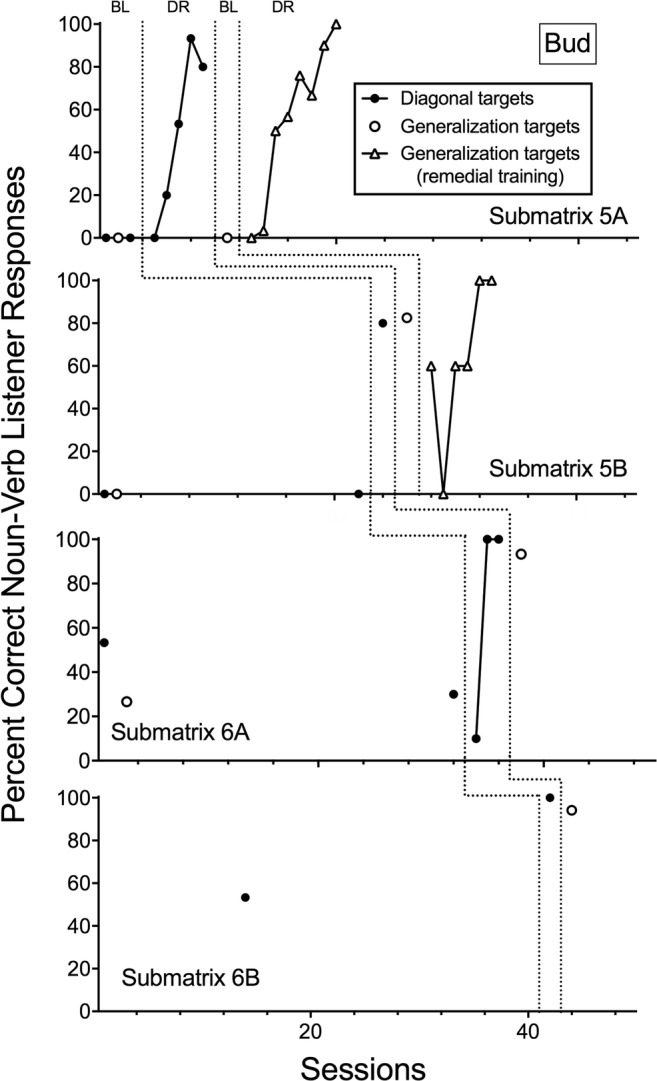
Percentage correct noun-verb listener responses across experimental sessions for Bud. Each panel shows data for each submatrix across baseline (BL) and differential reinforcement (DR) training sessions. Each data point depicts average percentage correct for all noun-verb combinations. Black data points reflect the three diagonal targets, whereas white data points reflect generalization targets. White triangular data points depict acquisition of generalization targets that did not meet mastery criteria in the recombinative generalization probe and required additional remedial training
For Submatrix 1B, tacting targets along the diagonal did not require teaching, as they all scored at 60% correct or above when probed. Similarly, only 4 of 24 generalization tacting targets required teaching to reach mastery. For Submatrix 2A, all diagonal targets required direct teaching, whereas only one of six generalization tacting targets of Submatrix 2A required additional training to reach mastery. Similarly, for Submatrix 2B, Hank scored 50% correct and required teaching for all diagonal targets, followed by four generalization targets requiring teaching to reach mastery criteria (see Figure 2 and Table 2).
Figure 3 shows Hank’s noun-verb listener responding data. During baseline, correct responding for listener responding targets was at moderate levels (40%–60%) for Submatrices 1A and 1B. The three diagonal targets of Submatrix 1A were mastered within 7–12 sessions (see Table 2 for average sessions to mastery; Figure 3 shows aggregate data for all targets). Upon probing for recombinative generalization, only one of six generalization targets required remedial training to reach mastery. Subsequently, diagonal targets for Submatrix 1B did not require additional training, as all three were above the 60% criteria for teaching during the first training session. Of the 24 generalization targets, three required remedial training (see Table 2 for the percentage of novel targets generalized). Listener response data for Matrix 2 are not displayed because Hank demonstrated performance at 80%–100% during initial training trials for all selected targets and these could no longer be used as listener response targets.
Fig. 3.
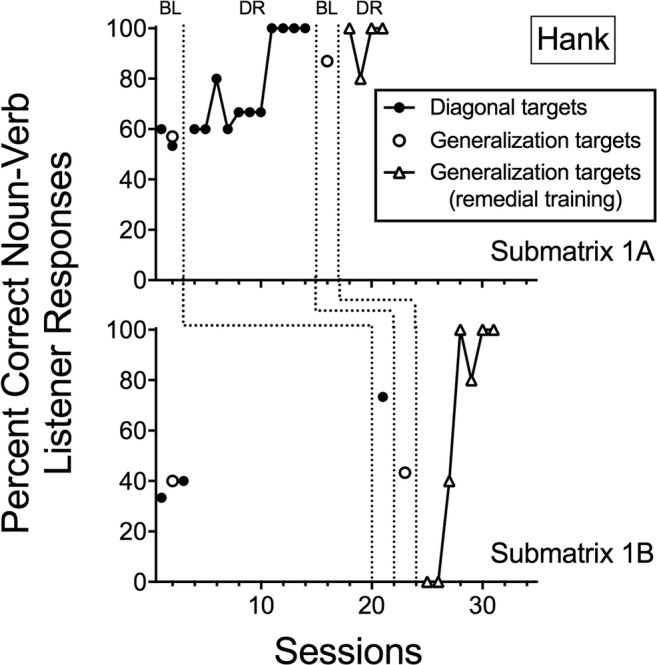
Percentage correct noun-verb listener responses across experimental sessions for Hank. Each panel shows data for each submatrix across baseline (BL) and differential reinforcement (DR) training sessions. Each data point depicts average percentage correct for all noun-verb combinations. Black data points reflect the three diagonal targets, whereas white data points reflect generalization targets. White triangular data points depict acquisition of generalization targets that did not meet mastery criteria in the recombinative generalization probe and required additional remedial training
For Iggy, correct responding for tacting targets was low (0%) during baseline for all submatrices (see Figure 4). The diagonal targets of Submatrix 3A were mastered within 4–11 sessions (see Table 2 for average sessions to mastery; Figure 4 shows aggregate data for all targets). When testing for recombinative generalization in Submatrix 3A, three of six tacting targets required remedial training. When diagonal tacting targets in Submatrix 3B were retested in the differential reinforcement condition, the percentage correct responses had increased but required 6–12 sessions to reach mastery (see Table 2 for average sessions to mastery; Figure 4 shows aggregate data for all targets). Next, probes for recombinative generalization revealed a majority of the generalization targets in Submatrix 3B were at mastery levels, with two tacting targets requiring additional training (see Table 2 for the percentage of novel targets generalized). The diagonal targets of Submatrix 4A were mastered within 4–11 training sessions. Probes for recombinative generalization in Submatrix 4A revealed that three of six tacting targets required remedial training to reach mastery criteria. Next, in Submatrix 4B, diagonal targets met mastery criteria within five to seven sessions, and of the generalization targets, two tacting targets required explicit training to reach mastery, which was accomplished within four to seven sessions (see Table 2 for the percentage of novel targets generalized and average sessions to mastery; Figure 4 shows aggregate data for all targets).
Fig. 4.
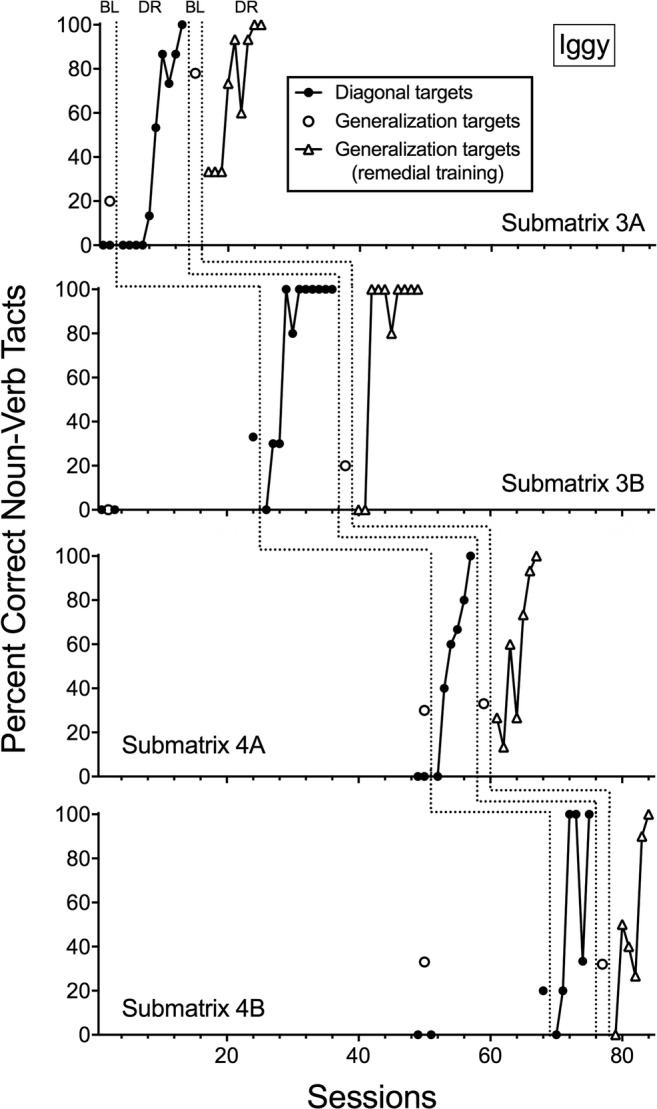
Percentage correct noun-verb tacts across experimental sessions for Iggy. Each panel shows data for each submatrix across baseline (BL) and differential reinforcement (DR) training sessions. Each data point depicts average percentage correct for all noun-verb combinations. Black data points reflect the three diagonal targets, whereas white data points reflect generalization targets. White triangular data points depict acquisition of generalization targets that did not meet mastery criteria in the recombinative generalization probe and required additional remedial training
Figure 5 shows aggregate noun-verb listener responding data for Iggy. Correct responding for listener responding targets was low (0%) during baseline for all submatrices, except in Submatrices 3B and 4B (20%–35%). The diagonal listener response targets of Submatrix 3A were mastered within 6–12 sessions (see Table 2 for average sessions to mastery; Figure 5 shows aggregate data for all targets). Probes for recombinative generalization in Submatrix 3A showed four of six listener response targets required remedial training to reach mastery levels (see Table 2 for the percentage novel targets generalized). When diagonal targets in Submatrix 3B were retested, all the listener responding targets were at mastery level. Subsequent probes for recombinative generalization revealed a majority of the generalization targets in Submatrix 3B were at mastery levels, with 3 of the 24 generalization targets requiring remedial training. As with tacting targets, the diagonal listener response targets of Submatrix 4A were mastered within 4–11 sessions (see Table 2 for average sessions to mastery; Figure 5 shows aggregate data for all targets). Probes for recombinative generalization in Submatrix 4A revealed that three of six listener response targets required additional training. In Submatrix 4B, the probe of diagonal targets prior to training revealed an increase in correct responding for one target, but this was still below the 60% correct threshold for inclusion as a training target. Upon introducing differential reinforcement, diagonal targets met mastery criteria within five to seven sessions (see Table 2 for average sessions to mastery; Figure 5 shows aggregate data for all targets). Of the 24 recombinative generalization targets, 4 listener response targets required explicit training to reach mastery.
Fig. 5.
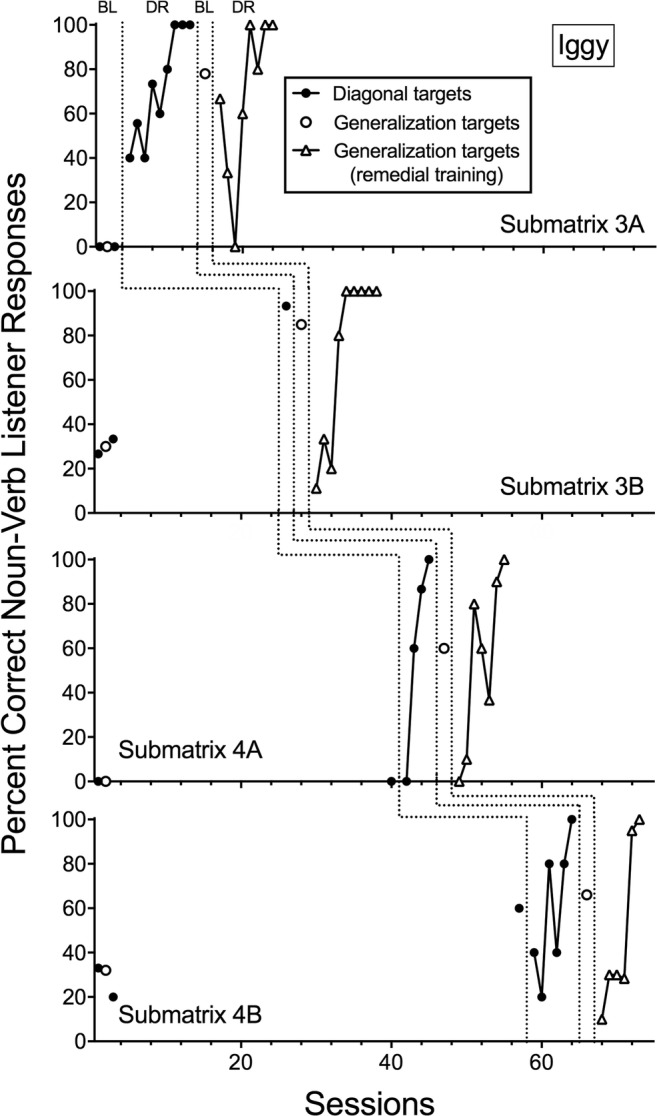
Percentage correct noun-verb listener responses across experimental sessions for Iggy. Each panel shows data for each submatrix across baseline (BL) and differential reinforcement (DR) training sessions. Each data point depicts average percentage correct for all noun-verb combinations. Black data points reflect the three diagonal targets, whereas white data points reflect generalization targets. White triangular data points depict acquisition of generalization targets that did not meet mastery criteria in the recombinative generalization probe and required additional remedial training
During baseline, Bud demonstrated low levels (0%) of correct responding for tacting in all submatrices (see Figure 6). The diagonal targets of Submatrix 5A were mastered within four to six sessions (see Table 2 for average sessions to mastery; Figure 6 shows aggregate data for all targets). When testing for recombinative generalization in Submatrix 5A, all targets required remedial training and were mastered within 7–14 sessions (see Table 2 for average sessions to mastery; Figure 6 shows aggregate data for all targets). All tacting targets in Submatrix 5B required teaching to meet mastery criteria, which was met within four to six sessions. Subsequently, probes for recombinative generalization revealed a majority of novel targets scored at mastery levels, with two requiring additional training (see Table 2 for the percentage of novel targets generalized). In Submatrix 6A, diagonal tacting targets met mastery criteria within three to five sessions, and all recombinative generalization targets met mastery criteria without explicit training (see Table 2 for average sessions to mastery; Figure 6 shows aggregate data for all targets). Further, all diagonal targets in Submatrix 6B met mastery criteria upon retesting after completing teaching diagonal targets in Submatrix 6A. Similarly, all generalization targets in Submatrix 6B met mastery criteria and did not require explicit teaching.
Fig. 6.
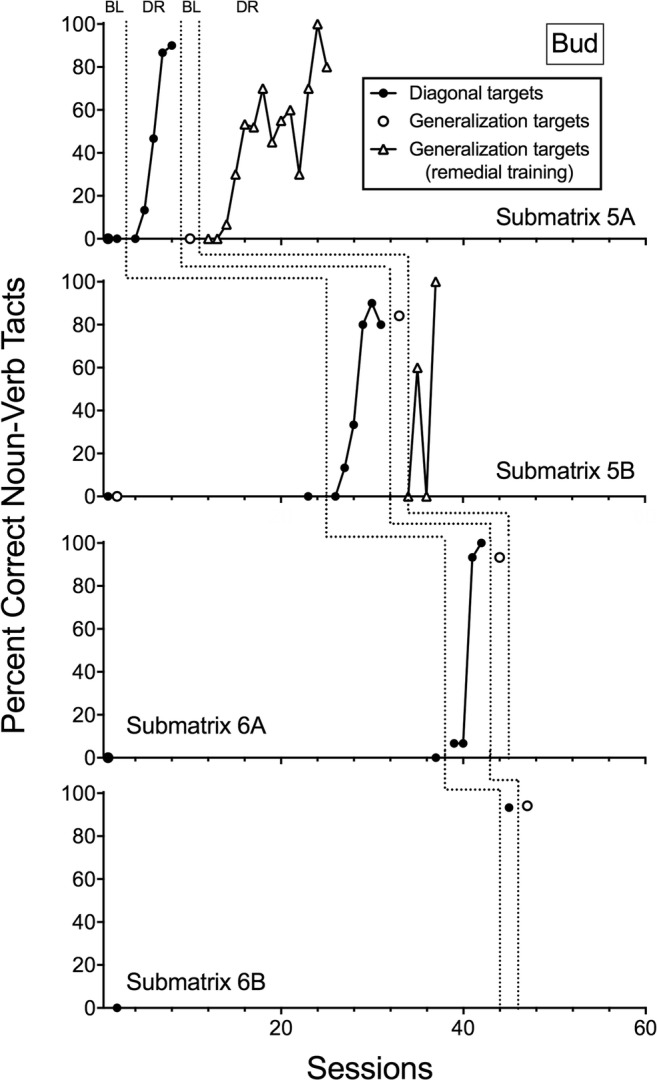
Percentage correct noun-verb tacts across experimental sessions for Bud. Each panel shows data for each submatrix across baseline (BL) and differential reinforcement (DR) training sessions. Each data point depicts average percentage correct for all noun-verb combinations. Black data points reflect the three diagonal targets, whereas white data points reflect generalization targets. White triangular data points depict acquisition of generalization targets that did not meet mastery criteria in the recombinative generalization probe and required additional remedial training
Similar to tacting, correct responding for listener responding targets in all submatrices during baseline was at low levels (0%) for Bud, except for listener responding targets in Submatrices 6A and 6B (55%; see Figure 7). The diagonal targets of Submatrix 5A for listener responding were mastered within three to six sessions (see Table 2 for average sessions to mastery; Figure 6 shows aggregate data for all targets). All recombinative generalization targets required remedial training, meeting mastery criteria within five to nine sessions of differential reinforcement. In Submatrix 5B, all diagonal listener responding targets met mastery criteria in the first training session, and one generalization target required explicit teaching to reach mastery levels. In Submatrix 6A, diagonal listener responding targets met mastery criteria within two to five sessions (see Table 2 for average sessions to mastery; Figure 6 shows aggregate data for all targets). Upon probing for recombinative generalization, all targets met mastery criteria. For Submatrix 6B, all diagonal listener responding targets, as well as all generalization targets, met mastery criteria in the first training session.
Data were collected for Hank and Bud on spontaneous noun-verb tacting occurring outside the experimental session (i.e., during early intervention sessions). Figure 8 shows cumulative spontaneous noun-verb tacting of novel and recombinative targets. Novel targets refer to noun-verb combinations that did not contain components included in the study (e.g., Mickey climbing), whereas recombinative targets refer to noun-verb combinations that contain one element (noun or verb) included in the study (e.g., Mickey sitting). Hank and Bud spontaneously emitted between 30 and 60 noun-verb novel and recombinative tacts outside the experimental sessions over the course of the observation period.
Fig. 8.
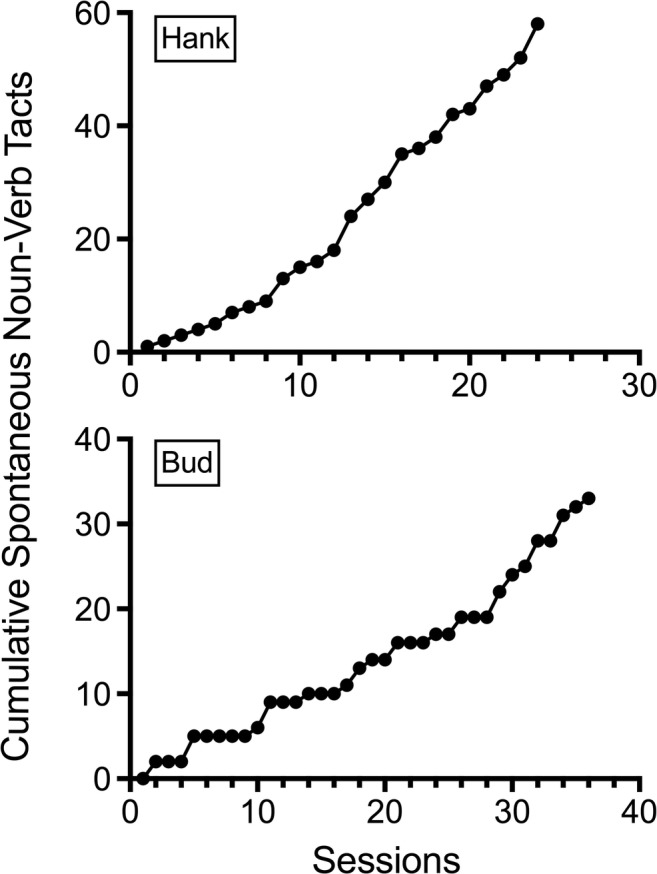
Cumulative novel and recombinative noun-verb tacts occurring spontaneously in the atural environment across sessions for Hank (top) and Bud (bottom)
Discussion
Matrix training has been proposed as a teaching method to promote recombinative generalization in children with ASD. Recently, the use of matrix training for the selection and arrangement of target stimuli has been shown to be effective for expanding the communication repertoire of children with ASD (e.g., Axe & Sainato, 2010; Curiel et al., 2016; Frampton et al., 2016). The present study sought to expand this literature by evaluating whether matrix training was an effective method for selecting targets to expand the noun-verb tacting and listener repertoires in children diagnosed with ASD. Particularly, the aim was to evaluate whether matrix training would promote recombinative generalization in children with ASD under the age of three. In all three participants, recombinative generalization of tacting and listener responding skills was observed when participants performed novel untaught noun-verb targets. Thus, gains in both tacting and listener responding skills were broader than the targets selected for direct teaching. The findings of the present study extend the literature on recombinative generalization and suggest directions for future research.
For all participants, the percentage of targets that showed recombinative generalization without explicit teaching increased from Submatrix A to B, suggesting matrix training can be a useful instructional strategy for expanding the communication repertoires of very young children with ASD. This finding is particularly relevant for two reasons. First, when programming language acquisition targets for young children with ASD, it may be beneficial to provide a history of contacting reinforcement for spontaneously recombining words. For children with ASD, rigid and scripted language is a common problem (APA, 2013) that could be inadvertently reinforced by providing highly structured language programming in which each target is taught separately. Instead, clinicians can promote flexible language structures (e.g., variable noun-verb combinations, variable use of manding frames) by arranging teaching targets in a matrix format. Second, it is likely that not all young children with ASD will demonstrate recombinative generalization to the same extent as the participants in the present study. Thus, the extent to which individuals can recombine language components in novel, untaught configurations may be indicative of the degree of behavioral rigidity and restrictive stimulus control of each individual and can be used to guide treatment (e.g., need to teach behavioral variability). In the present study, both tacting and listener skills were explicitly taught. It is possible, however, that transfer across verbal operants would be present without explicit teaching. Future studies should investigate whether training recombinative generalization with one verbal operant (e.g., tact) will transfer to other verbal operants (e.g., listener responding).
For Hank and Bud, acquisition of targets was faster for the matrix taught second (2 and 6, respectively). Although we argue this was due to the previous history with matrix training, it is possible some targets were acquired more readily than others due to their preference for the toys used for teaching in addition to the previous history of matrix training. For instance, acquisition of diagonal targets and recombinative generalization for Matrices 2 (Hank) and 6 (Bud) may have been impacted by the nature of the toys (i.e., vehicles). Both Hank and Bud showed preference for vehicles as leisure items during play in their EIBI sessions; as a result, it is possible they received additional exposure to tacts of actions associated with these items (e.g., rolling, crashing) relative to actions associated with figurines (e.g., waving, dancing). Further, it is possible that engaging with the vehicles may have been automatically reinforcing for these participants. Thus, the targets selected for the second matrices may have contributed to the faster acquisition and greater recombinative generalization observed. Despite this possibility, the recombinative generalization to untaught targets for all participants across matrices suggests this arrangement of teaching targets promoted the emergence of novel responses. Given the small number of participants, however, the present findings should be considered an initial validation of the use of matrix training in young children with ASD.
The use of preferred toys potentially contributed to Hank’s and Bud’s generalization of noun-verb tacting to the natural environment. Hank and Bud spontaneously emitted between 30 and 60 novel noun-verb and recombinative tacts outside the experimental sessions over the course of the observation period (see Figure 8). The gradual increase in spontaneous noun-verb tacts in the natural environment suggests teaching tacts in a manner that promotes recombinative generalization (i.e., matrix training) functioned to teach a complex language skill. Some have suggested this form of recombination may be a type of higher order operant or behavioral cusp (Frampton et al., 2016).
According to Rosales-Ruiz and Baer (1997), a behavioral cusp exposes individuals to novel responses or forms of stimulus control for existing responses, thereby allowing the individual to contact new contingencies in his or her environment. For instance, a child may be taught to imitate motor actions such as clapping hands and stomping feet upon hearing “do this.” Once this child can spontaneously imitate novel motor actions without explicit verbal instructions to imitate, it is said she has a generalized imitative repertoire, which is considered a behavioral cusp. Similarly, the spontaneous recombination of language components may be considered a behavioral cusp because it allows individuals to expand their expressive and receptive language without explicit teaching of all language components, consistent with how children without language delays acquire language. Usage of the noun-verb syntactic structure typically begins at a young age and serves as a foundational skill for longer utterances and increasingly complex language. Flexibility related to syntactic structure and word usage is crucial for adapting language to contextual changes (Mackay & Fields, 2009). Instructional matrices, such as those used in the present study, could promote syntactic flexibility in very young children with ASD.
The acquisition of untaught targets, or recombinative generalization, observed in the present study may be conceptualized through the perspective of derived stimulus relations and relational frame theory. The derived stimulus relation of equivalence refers to the emergence of unreinforced or untrained responses based on a small set of trained responses (Barnes-Holmes, Barnes-Holmes, & Cullinan, 2000; Barnes-Holmes, Finn, McEnteggart, & Barnes-Holmes, 2018). The extensive work on stimulus equivalence led to the conceptualization of relational frame theory (RFT; Hayes, 1991; Hayes, Barnes-Holmes, & Roche, 2001), according to which stimulus equivalence is one of many possible generalized relational operants common in human language. The history of reinforcement for some exemplars serves to establish patterns of generalized relational response units, called relational frames (Barnes-Holmes et al., 2018). It would be interesting for future studies to assess whether participants have the skill of naming prior to teaching noun-verb combinations. Naming is considered a verbal behavior cusp that allows individuals to learn bidirectional relations between words and objects incidentally (see Horne & Lowe, 1996; Miguel, 2016)
In analyzing the noun-verb combinations targeted in the present study, nouns may form a frame of coordination (i.e., relating stimuli on the basis of similarity, e.g., the class of objects that can be animated), verbs form a frame of coordination (i.e., class of actions objects can perform), nouns and verbs participate in a frame of distinction (i.e., the object performing the action is different from the action), and noun-verb combinations form a grammatical relational frame. From an RFT theory perspective, one can postulate that after a child is taught to respond to multiple exemplars of figurines performing actions by emitting various noun-verb tact combinations (e.g., baby walking, dog sleeping, cat sitting), the noun-verb syntactic structure transfers to other members of the noun and verb frames of coordination without direct teaching (e.g., baby sleeping, dog sitting, cat walking). This account provides a possible explanation for the recombinative generalization and spontaneous noun-verb tacts observed in the present study. Additionally, Hank’s and Bud’s faster acquisition of targets from the second taught matrix could be attributed to previous mastery of the frames of coordination of nouns and verbs, as well as the noun-verb grammatical relational frame.
In the present study, all participants demonstrated recombinative generalization within the nouns and verbs included in the matrices. Further, clinical data for Hank and Bud spontaneously emitting novel noun-verb combinations support the notion of matrix training promoting spontaneous recombination of language components as tact and listener responses. Results from the present study suggest matrix training led to the achievement of a behavioral cusp for all participants. It is unclear, however, the extent to which this higher order operant impacts performance on other tasks. Anecdotal observations during this study suggested participants might generalize skills acquired as verbal operants to other operant classes. Future studies should further evaluate whether the recombination generalizes across operant classes (e.g., tacting to play actions). The use of matrix training in clinical practice can lead to the rapid expansion of language through recombinative generalization. In turn, this can produce flexible language structures that do not require explicit training. In order to maximize clients’ time in EIBI, emphasis should be placed on interventions that develop behavioral cusps and relational frames, which can lead to large-scale changes in behavior.
Author Note
Corina Jimenez-Gomez, the Scott Center for Autism Treatment and Florida Institute of Technology; Sandhya Rajagopal, the Scott Center for Autism Treatment and Florida Institute of Technology; Regina Nastri, the Scott Center for Autism Treatment and Florida Institute of Technology; Ivy M. Chong, the Scott Center for Autism Treatment and Florida Institute of Technology.
Ivy M. Chong is now at the May Institute.
The authors thank Krystin Hussain, Krystal Aguirre, and Jeanine Tanz for their help in data collection. We also thank members of our research group for their valuable contributions during our weekly meetings.
Compliance with Ethical Standards
Conflict of Interest
The authors declare they have no conflicts of interest.
Ethical Approval
All procedures performed in studies involving human participants were in accordance with the ethical standards of the institutional and/or national research committee and with the 1964 Helsinki declaration and its later amendments or comparable ethical standards.
Footnotes
Highlights
• Matrix training, a form of generative instruction, refers to the arrangement and selection of teaching targets so that few targets are directly taught and novel combinations can be assessed for generalization.
• The use of matrix training promotes recombinative generalization in individuals with ASD and intellectual disabilities.
• Matrix training can be useful in generating a flexible use of language (e.g., novel noun-verb combinations) in young children with ASD.
• Future work evaluating whether recombinative generalization across operants occurs under matrix training arrangements is warranted.
Publisher’s Note
Springer Nature remains neutral with regard to jurisdictional claims in published maps and institutional affiliations.
References
- Alessi G. Generative strategies and teaching for generalization. The Analysis of Verbal Behavior. 1987;5:15–27. doi: 10.1007/BF03392816. [DOI] [PMC free article] [PubMed] [Google Scholar]
- American Psychiatric Association . Diagnostic and statistical manual of mental disorders (5th ed) Washington, DC: Author; 2013. [Google Scholar]
- Axe JB, Sainato DM. Matrix training of preliteracy skills with preschoolers with autism. Journal of Applied Behavior Analysis. 2010;43:635–652. doi: 10.1901/jaba.2010.43-635. [DOI] [PMC free article] [PubMed] [Google Scholar]
- Barnes-Holmes D, Barnes-Holmes Y, Cullinan V. Relational frame theory and Skinner’s Verbal behavior: A possible synthesis. The Behavior Analyst. 2000;23:69–84. doi: 10.1007/BF03392000. [DOI] [PMC free article] [PubMed] [Google Scholar]
- Barnes-Holmes D, Finn M, McEnteggart C, Barnes-Holmes Y. Derived stimulus relations and their role in a behavior-analytic account of human language and cognition. Perspectives on Behavioral Science. 2018;41:155–173. doi: 10.1007/s40614-017-0124-7. [DOI] [PMC free article] [PubMed] [Google Scholar]
- Conallen K, Reed P. A teaching procedure to help children with autistic spectrum disorder to label emotions. Research in Autism Spectrum Disorders. 2016;23:63–72. doi: 10.1016/j.rasd.2015.11.006. [DOI] [Google Scholar]
- Curiel ES, Sainato DM, Goldstein H. Matrix training of receptive language skills with a toddler with autism spectrum disorder: A case study. Education and Treatment of Children. 2016;39:95–109. [Google Scholar]
- Curiel, E. S. L., Sainato, D. M., & Goldstein, H. (2018). Matrix training for toddlers with autism spectrum disorder and other language delays. Journal of Early Intervention, 40, 268–284. 10.1177/1053815118788060.
- Dauphin M, Kinney EM, Stromer R. Using video-enhanced activity schedules and matrix training to teach sociodramatic play to a child with autism. Journal of Positive Behavior Interventions. 2004;6:238–250. doi: 10.1177/10983007040060040501. [DOI] [Google Scholar]
- DeLeon IG, Iwata BA. Evaluation of a multiple-stimulus presentation format for assessing reinforcer preferences. Journal of Applied Behavior Analysis. 1996;29:519–533. doi: 10.1901/jaba.1996.29-519. [DOI] [PMC free article] [PubMed] [Google Scholar]
- Esler AN, Hus Bal V, Guthrie W, Wetherby A, Weismer SE, Lord C. The autism diagnostic observation schedule, toddler module: Standardized severity scores. Journal of Autism and Developmental Disorders. 2015;45:2704–2720. doi: 10.1007/s10803-015-2432-7. [DOI] [PMC free article] [PubMed] [Google Scholar]
- Frampton SE, Wymer SC, Hansen B, Shillingsburg MA. The use of matrix training to promote generative language with children with autism. Journal of Applied Behavior Analysis. 2016;49:869–883. doi: 10.1002/jaba.340. [DOI] [PubMed] [Google Scholar]
- Goldstein H. Recombinative generalization: Relationships between environmental conditions and the linguistic repertoires of language learners. Analysis and Intervention in Developmental Disabilities. 1983;3:279–293. doi: 10.1016/0270-4684(83)90002-2. [DOI] [Google Scholar]
- Goldstein H, Angelo D, Mousetis L. Acquisition and extension of syntactic repertoires by severely mentally retarded youth. Research in Developmental Disabilities. 1987;8:549–574. doi: 10.1016/0891-4222(87)90054-0. [DOI] [PubMed] [Google Scholar]
- Goldstein H, Mousetis L. Generalized language learning by children with severe mental retardation: Effects of peers’ expressive modeling. Journal of Applied Behavior Analysis. 1989;22:245–259. doi: 10.1901/jaba.1989.22-245. [DOI] [PMC free article] [PubMed] [Google Scholar]
- Hayes SC. A relational control theory of stimulus equivalence. Reno, NV: Context Press; 1991. [Google Scholar]
- Hayes SC, Barnes-Holmes D, Roche B. Relational frame theory: A post-Skinnerian account of human language and cognition. New York, NY: Plenum; 2001. [DOI] [PubMed] [Google Scholar]
- Horne PJ, Lowe CF. On the origins of naming and other symbolic behavior. Journal of the Experimental Analysis of Behavior. 1996;65:185–241. doi: 10.1901/jeab.1996.65-185. [DOI] [PMC free article] [PubMed] [Google Scholar]
- Jung S, Sainato DM. Teaching play skills to young children with autism. Journal of Intellectual and Developmental Disability. 2013;38:74–90. doi: 10.3109/13668250.2012.732220. [DOI] [PubMed] [Google Scholar]
- Kinney EM, Vedora J, Stromer R. Computer-presented video models to teach generative spelling to a child with an autism spectrum disorder. Journal of Positive Behavior Interventions. 2003;5:22–29. doi: 10.1177/10983007030050010301. [DOI] [Google Scholar]
- Lord C, Rutter M, DiLavore PC, Risi S. Autism diagnostic observation schedule: Manual. Los Angeles, CA: Western Psychological Services; 1999. [Google Scholar]
- Lovaas OI. Behavioral treatment and normal educational and intellectual functioning in young autistic children. Journal of Consulting and Clinical Psychology. 1987;55:3–9. doi: 10.1037/0022-006X.55.1.3. [DOI] [PubMed] [Google Scholar]
- MacDuff GS, Krantz PJ, McClannahan LE. Prompts and prompt-fading strategies for people with autism. In: Maurice C, Green G, Foxx RM, editors. Making a difference: Behavioral intervention for autism. Austin, TX: Pro-Ed; 2001. pp. 37–50. [Google Scholar]
- Mackay HA, Fields L. Syntax, grammatical transformation, and productivity: A synthesis of stimulus sequences, equivalence classes, and contextual control. In: Rehfeldt RA, Barnes-Holmes Y, editors. Derived relational responding applications for learners with autism and other developmental disabilities: A progressive guide to change. Oakland, CA: New Harbinger Publications; 2009. [Google Scholar]
- Miguel CF. Common and intraverbal bidirectional naming. The Analysis of Verbal Behavior. 2016;32:125–138. doi: 10.1007/s40616-016-0066-2. [DOI] [PMC free article] [PubMed] [Google Scholar]
- Rehfeldt RA, Barnes-Holmes Y. Derived relational responding: Applications for learners with autism and other developmental disabilities. Oakland, CA: New Harbinger Publications; 2009. [Google Scholar]
- Rosales-Ruiz J, Baer DM. Behavioral cusps: A developmental and pragmatic concept for behavior analysis. Journal of Applied Behavior Analysis. 1997;30:533–544. doi: 10.1901/jaba.1997.30-533. [DOI] [PMC free article] [PubMed] [Google Scholar]
- Sidman M. Equivalence relations and behavior: A research story. Boston, MA: Authors Cooperative; 1994. [Google Scholar]
- Stokes TF, Baer DM. An implicit technology of generalization. Journal of Applied Behavior Analysis. 1977;10:349–367. doi: 10.1901/jaba.1977.10-349. [DOI] [PMC free article] [PubMed] [Google Scholar]
- Sundberg ML. Verbal behavior milestones assessment and placement program: The VB-MAPP (2nd ed.) Concord, CA: AVB Press; 2008. [Google Scholar]
- Wilson ER, Wine B, Fitterer K. An investigation of the matrix training approach to teach social play skills. Behavioral Interventions. 2017;32:278–284. doi: 10.1002/bin.1473. [DOI] [Google Scholar]



